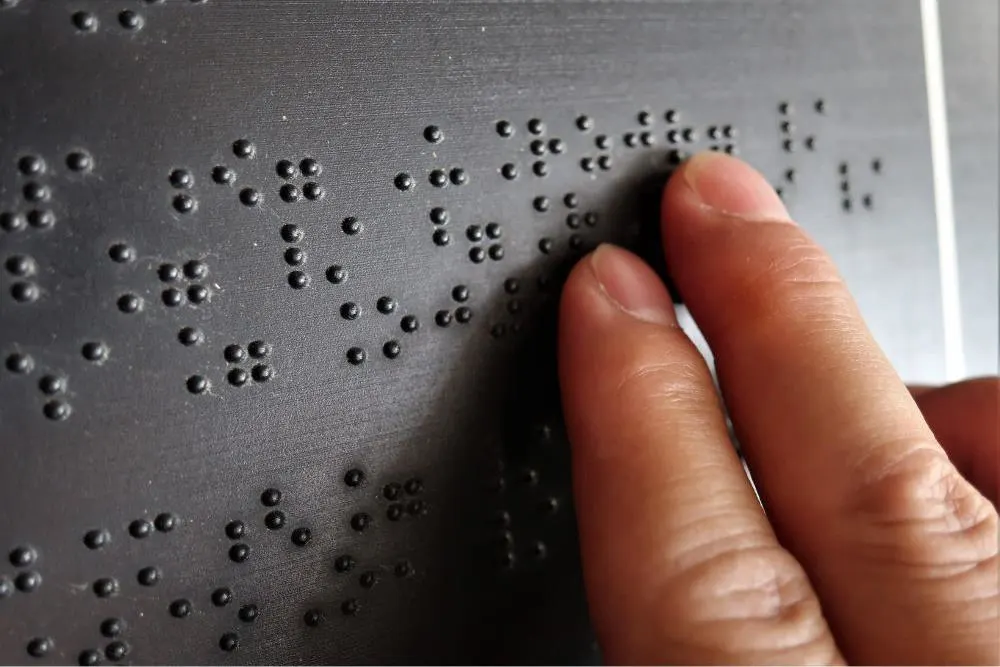Becoming a braille translator is a rewarding career choice for those who are passionate about helping visually impaired individuals access information and written content.

Braille translators play a crucial role in ensuring that print materials are accurately and effectively converted into braille, a tactile reading and writing system used by people with visual disabilities. With the right training, certification, and dedication, anyone can pursue this fulfilling profession and make a positive impact on the lives of many.
To start your journey towards becoming a braille translator, it is essential to have a high school diploma or equivalent, as well as fluency in braille. This foundational knowledge is typically gained through on-the-job training or specialized courses offered by institutions such as the National Federation of the Blind and the North Orange Continuing Education. These programs provide aspiring braille translators with necessary skills in literary, mathematics, and music transcribing. Once completed, they can then obtain Library of Congress certification, which is a requirement for many public school transcriber positions and other professional opportunities.
Understanding the Role of a Braille Translator
Braille Transcribers vs. Braille Translators
Braille is a tactile writing system used by blind and visually impaired people to read and write. A Braille transcriber is a professional who manually transcribes printed text into Braille, whereas a Braille translator is a software program that automatically converts electronic text (such as an MS-Word file) into Braille and sends it to a Braille peripheral, like a Braille embosser, which produces a hard copy of the newly created Braille 1. Each language typically needs its own Braille translator.
Career Path and Skill Sets
Becoming a Braille translator requires a solid understanding of Braille and proficiency in the specific Braille code you’ll be working with, such as literary, music, or mathematics. Many Braille translators start off as Braille transcribers. According to Spiegato, a person who has received Braille training can work for a company that produces Braille materials as a Braille translator. A translator typically begins with smaller projects under supervision and builds up their skills over time, eventually taking on larger projects. Some people choose to specialize in specific areas, such as scientific or legal transcription.
Apart from Braille knowledge, a Braille translator should possess:
- Strong attention to detail
- Excellent communication skills
- Good time management abilities
- Basic computer skills
- Adaptability to work with various software programs
Contracted and Uncontracted Braille
There are two main types of Braille: Contracted Braille and Uncontracted Braille. Contracted Braille, also known as Grade 2 Braille, uses contractions and abbreviations to represent common words or letter combinations, making the text more compact and efficient to read. Uncontracted Braille, also called Grade 1 Braille, is a basic form that uses a unique symbol for each character without contractions, allowing novice Braille readers to learn the system more easily 2.
As a Braille translator, it is essential to understand both contracted and uncontracted Braille, as your role may require you to convert text into either type, depending on the needs of the project and the intended audience.

Skills and Requirements
Language and Communication Skills
To become a successful braille transcriber, you must have strong language and communication skills. A high school diploma or equivalent is necessary, and fluency in both English and braille is crucial. In some cases, knowledge of a foreign language may be required if you plan to translate braille into other languages. It’s essential to understand the braille alphabet and code standards to ensure accurate translations.
Mathematics and Music Transcribing
In addition to language skills, a braille transcriber should be proficient in mathematics and music transcribing. These specialized skill sets are important for accurately translating mathematical equations and braille music notations. Taking relevant courses or training in these areas can help you develop these skills.
Proofreading and Editing Abilities
An efficient braille transcriber must possess exceptional proofreading and editing skills. This is vital to ensure that the translated texts are error-free and meet the required braille codes and standards. A meticulous approach to reviewing work and the ability to collaborate with others, such as editors and clients, is necessary.
Computer Skills and Software Knowledge
In today’s technology-driven world, a braille transcriber must have strong computer skills and be familiar with software commonly used for braille translation. This includes the ability to use braille output devices, embossers, and transcription software. Familiarity with general office software, such as word processors and spreadsheets, is also crucial.
By developing these skills and gaining the necessary knowledge, you will be well-prepared to pursue a successful career as a braille transcriber. Don’t forget to explore braille training and certification options to further hone your abilities and demonstrate your expertise in the field.
Education and Certification Process
Braille Training Courses
To become a Braille translator, it’s essential to acquire the necessary skills in Braille transcription. Several organizations offer Braille training courses to help individuals gain proficiency in Braille codes and standards. High school diploma or equivalent is a pre-requisite for these courses. These training courses often cover literary Braille, mathematics Braille, and music Braille transcription. Many individuals also gain practical knowledge through on-the-job training experiences.
Braille Certification
After completing the Braille training courses, aspiring Braille translators need to obtain a Braille certification. This certification is issued by the Library of Congress and is a mandatory requirement for public school transcriber positions. To earn the certification, candidates must pass an examination consisting of multiple sections that test their Braille literacy and transcription abilities.
Specialized Certifications for Mathematics, Music, and Proofreading
As a Braille translator, it is possible to further specialize in specific areas of transcription, such as:
-
Mathematics Braille Transcribing: This specialization requires a deep understanding of the Nemeth Code, which is used for translating mathematical and scientific content into Braille.
-
Music Braille Transcribing: In this area, knowledge of the Music Braille Code is crucial for translating musical notations and other relevant content into Braille.
-
Literary Braille Proofreading: This specialization focuses on assessing and correcting Braille translations to ensure accuracy and adherence to Braille codes and formatting guidelines.
Aspiring Braille translators can pursue these specialized certifications to enhance their skills and expertise in each domain. These specializations may open up more career opportunities for certified Braille translators.
Overall, the journey to become a Braille translator involves education, certification, and continuous learning for excellence in various Braille transcription domains.
Career Opportunities and Salary Expectations
Full-time, Part-time, and Freelance Options
Braille translators have various work options, allowing them to choose the best fit for their lifestyle and career goals. They can work as full-time or part-time employees for organizations, or they can work on a freelance basis. Full-time Braille translators typically find employment at libraries, publishing companies, or schools, while part-time translators may work on specific projects or with limited hours. Freelancers can work independently, providing their services to individual clients or companies on a project basis.
Industries and Settings for Braille Translators
Braille translators are needed across various sectors to make written content accessible for visually impaired individuals. Some common industries and settings where Braille translators can find work include:
- Libraries: assisting in making books and other materials accessible
- Publishing companies: converting text from books, journals, and articles into Braille
- Educational institutions: working with schools and universities to provide resources for visually impaired students
- Government agencies: creating accessible materials for a wide range of purposes
- Non-profit organizations: helping create resources for the blind and visually impaired community
Income Potential
The income potential for a Braille translator can vary depending on factors such as experience, location, and the type of work they choose. According to Salary Expert, Braille translators can earn an average salary ranging from $38,000 to $49,000 per year. This number can increase for more experienced Braille translators who have developed a strong reputation in the field.
When considering a career as a Braille translator, it’s essential to have a solid understanding of Braille codes and standards, as well as fluent command in the language. Many Braille translators acquire this knowledge through on-the-job training and certification programs. With dedication and continued learning, Braille translators can find rewarding career opportunities and contribute to making the world more accessible for the visually impaired.
Resources for Braille Translators
Becoming a braille translator requires dedication, training, and access to a variety of resources. Here, we cover the essentials for anyone interested in joining the field.
Directory of Producers of Accessible Reading Materials
The Directory of Producers of Accessible Reading Materials is a valuable resource for Braille translators working on textbooks and other educational materials. It provides a comprehensive list of organizations and companies that produce and distribute accessible materials for blind or visually impaired individuals. This directory can help you find potential clients and get a better understanding of the market for braille translation services.
Professional Organizations and Networking Opportunities
As a braille translator, it’s important to engage with professional organizations to stay updated on the latest advancements, best practices, and networking opportunities. The National Federation of the Blind offers resources for braille transcription, as well as certifications and training programs to enhance your skills. Additionally, the American Foundation for the Blind provides resources on assistive technology products and braille translators.
Advancements in Technology
In the world of braille translation, technology plays a crucial role in making the process more efficient and accurate. There have been significant developments in braille translation software, such as BrailleBlaster, which can help you translate English language text into braille quickly and efficiently. Some of these tools leverage artificial intelligence to improve the accuracy of their translations, making it easier for braille translators to produce high-quality materials in a shorter amount of time.
Another advancement in technology has been the creation of electronic braille displays, allowing blind or visually impaired individuals to read digital materials in braille. As a braille translator, staying informed about these technological advancements can help you stay ahead in your career and better meet the needs of your clients.
In conclusion, there are numerous resources and opportunities for aspiring braille translators to access and utilize in order to excel in their careers. By staying informed and taking advantage of these tools and networks, you can ensure success in the field of braille translation.
